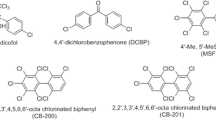Abstract
Technical dichlorodiphenyltrichloroethane (DDT) has been used worldwide as a pesticide since the beginning of the 1940s. Due to its persistence, DDT residues are still ubiquitously distributed in the environment. Photochemical UV degradation has been shown to be a potent degradation path for DDT and most of the resulting photoproducts have been identified up to now. Nevertheless, in 2012, a new DDT metabolite, most likely formed photochemically from DDE, was detected in ray liver samples from Brazil, an area which is highly contaminated with DDT. This study includes photochemical generation, chemical synthesis and isolation of this compound which was verified to consist of both cis- and trans-2,4-dichloro-1-[2-chloro-1-(4-chlorophenyl)ethenyl]benzene. Both stereoisomers were resolved by gas chromatography on a polar capillary column and detected in more than 60 biotic (e.g. marine mammals, birds, human milk) and abiotic samples (fat deposits in kitchen hoods) from different areas all over the world. The stereoisomer distribution and concentrations (0.3–3.9% relative to corresponding 1,1-dichloro-2,2-bis(p-chlorophenyl) ethane (p,p′-DDE) levels) were determined by means of the synthesized analytical standard, indicating the widespread occurrence of this compound as an additional minor metabolite of DDT.









Similar content being viewed by others
References
Bacon CE, Jarman WM, Costa DP (1992) Organochlorine and polychlorinated biphenyl levels in pinniped milk from the Arctic, the Antarctic, California and Australia. Chemosphere 24(6):779–791. doi:10.1016/0045-6535(92)90538-3
Becker HGO (2009) Organikum. Wiley-VCH, Weinheim
Bendig P, Hägele F, Vetter W (2013) Widespread occurrence of polyhalogenated compounds in fat from kitchen hoods. Anal Bioanal Chem 405:7485–7496
Bendig P, Vetter W (2013) UV-induced formation of bromophenols from polybrominated diphenyl ethers. Environ Sci Technol 47(8):3665–3670
Borrell A (1993) PCB and DDT in blubber of cetaceans from the northeastern north Atlantic. Mar Pollut Bull 26(3):146–151. doi:10.1016/0025-326X(93)90125-4
Bouwman H, Van Den Berg H, Kylin H (2011) DDT and malaria prevention: addressing the paradox. Environ Health Perspect 119(6):744–747
Burgers J, Opdam P, Müskens G, Ed R (1986) Residue levels of DDE in eggs of Dutch sparrowhawks Accipiter nisus following the ban on DDT. Environmental pollution. Series B, Chemical and Physical 11(1):29–40. doi:10.1016/0143-148X(86)90030-3
Clausen J, Braestrup L, Berg O (1974) The content of polychlorinated hydrocarbons in Arctic mammals. Bull Environ Contam Toxicol 12(5):529–534. doi:10.1007/BF01684914
Convention text of the Stockholm Convention on Persistent Organic Pollutants (2015), 2015
Corsolini S, Romeo T, Ademollo N, Greco S, Focardi S (2002) POPs in key species of marine Antarctic ecosystem. Microchem J 73(1–2):187–193. doi:10.1016/S0026-265X(02)00063-2
Covaci A, Gheorghe A, Schepens P (2004) Distribution of organochlorine pesticides, polychlorinated biphenyls and α-HCH enantiomers in pork tissues. Chemosphere 56(8):757–766. doi:10.1016/j.chemosphere.2004.02.014
Fernández P, Grimalt JO (2003) On the global distribution of persistent organic pollutants. Chimia 57(9):514–521
Fishbein L (1974) Chromatographic and biological aspects of DDT and its metabolites. J Chromatogr 98(1):177–251
Fulmer GR, Miller AJM, Sherden NH, Gottlieb HE, Nudelman A, Stoltz BM, Bercaw JE, Goldberg KI (2010) NMR chemical shifts of trace impurities: common laboratory solvents, organics, and gases in deuterated solvents relevant to the organometallic chemist. Organometallics 29(9):2176–2179
Gallistl C, Vetter W (2016) Synthesis, liquid chromatographic fractionation and partial characterization of polybrominated dibenzofuran congeners. J Chromatogr A 1442:62–72
Garrison AW, Cyterski M, Roberts KD, Burdette D, Williamson J, Avants JK (2014) Occurrences and fate of DDT principal isomers/metabolites, DDA, and o,p’-DDD enantiomers in fish, sediment and water at a DDT-impacted superfund site. Environ Pollut 194:224–234
Glynn A, Lignell S, Darnerud PO, Aune M, Ankarberg EH, Bergdahl IA, Barregård L, Bensryd I (2011) Regional differences in levels of chlorinated and brominated pollutants in mother’s milk from primiparous women in Sweden. Environ Int 37(1):71–79. doi:10.1016/j.envint.2010.07.003
Göthe R, Wachtmeister CA, Åkermark B, Baeckström P, Jansson B, Jensen S (1976) Photo-isomerisation and photo-degradation of DDE. Tetrahedron Lett 17(49):4501–4504
Haller HL, Bartlett PD, Drake NL, Newman MS, Cristol SJ, Eaker CM, Hayes RA, Kilmer GW, Magerlein B, Mueller GP, Schneider A, Wheatley W (1945) The chemical composition of technical DDT. J Am Chem Soc 67(9):1591–1602
Heintzelman DS (1964) Spring and summer sparrow hawk food habits. The Wilson Bulletin 76(4):323–330
Hui LL, Hedley AJ, Kypke K, Cowling BJ, Nelson EAS, Wong TW, Van Leeuwen FXR, Malisch R (2008) DDT levels in human milk in Hong Kong, 2001-02. Chemosphere 73(1):50–55
Jara-Carrasco S, Barra R, Espejo W, Celis JE, González-Acunã D, Chiang G, Sánchez-Hernández J (2017) Persistent organic pollutants and porphyrin levels in excreta of penguin colonies from the Antarctic peninsula area. Polar Record 53(1):79–87. doi:10.1017/S0032247416000607
Kalantzi OI, Hall AJ, Thomas GO, Jones KC (2005) Polybrominated diphenyl ethers and selected organochlorine chemicals in grey seals (Halichoerus grypus) in the North Sea. Chemosphere 58(3):345–354. doi:10.1016/j.chemosphere.2004.07.039
Kapp T, Kammann U, Vobach M, Vetter W (2006) Synthesis of low and high chlorinated toxaphene and comparison of their toxicity by zebrafish (Danio rerio) embryo test. Environ Toxicol Chem 25(11):2884–2889
Karolewski MA, Lukowski AB, Halba R (1987) Residues of chlorinated hydrocarbons in the adipose tissue of the Antarctic pinnipeds. Polish Polar Research 8(2):189–197
Kerner I, Klein W, Korte F (1972) Beiträge zur ökologischen Chemie-XXXIII. Photochemische Reaktionen von 1,1-dichlor-2(p,p’-dichlorphenyl)äthylen (DDE). Tetrahedron 28(6):1575–1578. doi: 10.1016/0040-4020(72)88039-6
Krone O, Stjernberg T, Kenntner N, Tataruch F, Koivusaari J, Nuuja I (2006) Mortality factors, helminth burden, and contaminant rresidues in white-tailed sea eagles (Haliaeetus albicilla) from Finland. AMBIO: A Journal of the Human Environment 35(3):98–104. doi:10.1579/0044-7447(2006)35[98:MFHBAC]2.0.CO;2
Linden H, Wikman M (1983) Goshawk predation on tetraonids: availability of prey and diet of the predator in the breeding season. J Anim Ecol 52(3):953–968
Mackintosh SA, Dodder NG, Shaul NJ, Aluwihare LI, Maruya KA, Chivers SJ, Danil K, Weller DW, Hoh E (2016) Newly identified DDT-related compounds accumulating in Southern California bottlenose dolphins. Environ Sci Technol 50(22):12129–12137. doi:10.1021/acs.est.6b03150
Mañosa S, Mateo R, Freixa C, Guitart R (2003) Persistent organochlorine contaminants in eggs of northern goshawk and Eurasian buzzard from northeastern Spain: temporal trends related to changes in the diet. Environ Pollut 122(3):351–359. doi:10.1016/S0269-7491(02)00334-2
Nikolova-Damyanova B (2009) Retention of lipids in silver ion high-performance liquid chromatography: facts and assumptions. J Chromatogr A 1216(10):1815–1824. doi:10.1016/j.chroma.2008.10.097
Nordlöf U, Helander B, Eriksson U, Zebühr Y, Asplund L (2012) Comparison of organohalogen compounds in a white-tailed sea eagle egg laid in 1941 with five eggs from 1996 to 2001. Chemosphere 88(3):286–291. doi:10.1016/j.chemosphere.2012.02.039
Oehme M, Schlabach M, Hummert K, Luckas B, Nordøy ES (1995) Determination of levels of polychlorinated dibenzo-p-dioxins, dibenzofurans, biphenyls and pesticides in harp seals from the Greenland Sea. Sci Total Environ 162(2–3):75–91. doi:10.1016/0048-9697(95)04419-2
Peeran SG, Reddy GH (1990) Syntheses and mass spectral rearrangements of unsaturated bis-sulphides and bis-sulphones. Phosphorus Sulfur Silicon Relat Elem 54(1–4):9–22
Poulsen AH, Kawaguchi S, Kukkonen JVK, Leppänen MT, Nash SMB (2012) Aqueous uptake and sublethal toxicity of p,p’-DDE in non-feeding larval stages of Antarctic krill (Euphausia superba). Environ Pollut 160(1):185–191
Ricking M, Schwarzbauer J (2012) DDT isomers and metabolites in the environment: an overview. Environ Chem Lett 10(4):317–323
Rogan WJ, Chen A (2005) Health risks and benefits of bis(4-chlorophenyl)-1,1,1-trichloroethane (DDT). Lancet 366(9487):763–773
Roosens L, Abdallah MAE, Harrad S, Neels H, Covaci A (2010) Current exposure to persistent polychlorinated biphenyls (PCBs) and dichlorodiphenyldichloroethylene (p,p′-DDE) of Belgian students from food and dust. Environ Sci Technol 44(8):2870–2875. doi:10.1021/es9021427
Rosenfelder N, Lehnert K, Kaffarnik S, Torres JPM, Vianna M, Vetter W (2012) Thorough analysis of polyhalogenated compounds in ray liver samples off the coast of Rio de Janeiro, Brazil. Environ Sci Pollut Res 19(2):379–389
Rueggeberg WHC, Torrans DJ (1946) Production of DDT. Ind Eng Chem 38(2):211–214. doi:10.1021/ie50434a026
Schwack W (1984) Photochemical reactions of pesticides with constituents of plant cuticles—I. Model reactions of DDT and methoxychlor with cyclohexene. Z Lebensm Unters Forsch 179(5):389–393
Sheng J, Wang X, Gong P, Joswiak DR, Tian L, Yao T, Jones KC (2013) Monsoon-driven transport of organochlorine pesticides and polychlorinated biphenyls to the tibetan plateau: three year atmospheric monitoring study. Environ Sci Technol 47(7):3199–3208
Sudharshan S, Naidu R, Mallavarapu M, Bolan N (2012) DDT remediation in contaminated soils: a review of recent studies. Biodegradation 23(6):851–863
Tebourbi O, Driss M, Sakly M, Rhouma K (2006) Metabolism of DDT in different tissues of young rats. Journal of Environmental Science and Health - Part B Pesticides, Food Contaminants, and Agricultural Wastes 41(2):167–176. doi:10.1080/03601230500364674
Thurnhofer S, Hottinger G, Vetter W (2007) Enantioselective determination of anteiso fatty acids in food samples. Anal Chem 79(12):4696–4701. doi:10.1021/ac0702894
Torres JPM, Pfeiffer WC, Markowitz S, Pause R, Malm O, Japenga J (2002) Dichlorodiphenyltrichloroethane in soil, river sediment, and fish in the Amazon in Brazil. Environ Res 88(2):134–139
Turusov V, Rakitsky V, Tomatis L (2002) Dichlorodiphenyltrichloroethane (DDT): ubiquity, persistence, and risks. Environ Health Perspect 110(2):125–128
Vetter W, Kirres J, Bendig P (2011) Bromination of 2-methoxydiphenyl ether to an average of tetrabrominated 2-methoxydiphenyl ethers. Chemosphere 84(8):1117–1124
Vetter W, Luckas B (1995) Synthesis, isolation, and chromatography of perdeuterated α−1,2,3,4,5,6-hexachlorocyclohexane. J High Resolut Chromatogr 18(10):643–646. doi:10.1002/jhrc.1240181006
Vetter W, Luckas B, Heidemann G, Skírnisson K (1996) Organochlorine residues in marine mammals from the northern hemisphere—a consideration of the composition of organochlorine residues in the blubber of marine mammals. Sci Total Environ 186(1–2):29–39
Vetter W, Weichbrodt M, Scholz E, Luckas B, Oelschläger H (1999) Levels of organochlorines (DDT, PCBs, toxaphene, chlordane, dieldrin, and HCHs) in blubber of South African fur seals (Arctocephalus pusillus pusillus) from cape Cross/Namibia. Mar Pollut Bull 38(9):830–836
Villegas C, Zhao Y, Curtis JM (2010) Two methods for the separation of monounsaturated octadecenoic acid isomers. J Chromatogr A 1217(5):775–784. doi:10.1016/j.chroma.2009.12.011
Voldner EC, Li Y-F (1995) Global usage of selected persistent organochlorines. Sci Total Environ 160-161(C):201–210
Zepp RG, Wolfe NL, Azarraga LV, Cox RH, Pape CW (1977) Photochemical transformation of the DDT and methoxychlor degradation products, DDE and DMDE, by sunlight. Arch Environ Contam Toxicol 6(1):305–314
Acknowledgements
The authors are thankful to Dr. Jürgen Conrad (Institute of Chemistry, Section of Bioorganic Chemistry, University of Hohenheim, Germany) for support of the NMR measurements. We gratefully acknowledge the German Academic Exchange Service (DAAD) for support of the internship of Katie Proctor within the DAAD/RISE Germany scholarship program 2016. Furthermore, we are thankful for all people who provided the samples available from previous studies. Dr. Gregor Scheiffarth from the Lower Saxony Tidelands National Park Administration (NLPV Wattenmeer) is acknowledged for providing us blubber samples from a stranded sperm whale. A special permission regarding the transportation and analysis of these samples in agreement with the Federal Act for the Protection of Nature was kindly provided by the Lower Saxony Tidelands National Park Administration.
Author information
Authors and Affiliations
Corresponding author
Ethics declarations
Conflict of interest
The authors declare that they have no conflict of interest.
Additional information
Responsible editor: Philippe Garrigues
Electronic supplementary material
ESM 1
(PDF 724 kb)
Rights and permissions
About this article
Cite this article
Gallistl, C., Proctor, K., Bader, K. et al. Synthesis of the DDT metabolite 2,4-dichloro-1-[2-chloro-1-(4-chlorophenyl)ethenyl]benzene (o-Cl-DDMU) and its detection in abiotic and biotic samples. Environ Sci Pollut Res 24, 16815–16828 (2017). https://doi.org/10.1007/s11356-017-9173-4
Received:
Accepted:
Published:
Issue Date:
DOI: https://doi.org/10.1007/s11356-017-9173-4




